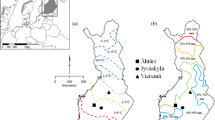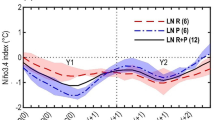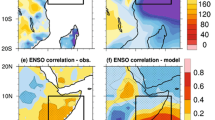Abstract
The wet season of Florida is well defined and is invariably centered in the boreal summer season of June–July–August. In this observational study we objectively define the Length of the Wet Season (LOWS) for Florida and examine its variations with respect to El Niño and the Southern Oscillation (ENSO) and the Atlantic Warm Pool (AWP). Our study reveals that ENSO variability has a profound influence on the LOWS especially over south Florida and parts of panhandle Florida prior to 1976. In the post-1976 era the influence of ENSO has significantly diminished. Our results show that in this pre-1976 era, warm (cold) ENSO events in the boreal winter are followed by long (short) LOWS over the region. This variation is consistent with warm (cold) ENSO events influencing early (late) onset of the wet season in the region. There is significant relationship of the LOWS in south and northeast Florida with the variation of the AWP. Unlike the teleconnection with ENSO the relationship of the demise of the wet season with AWP is stronger in the post-1976 period compared to the pre-1976 period. Furthermore the variability of the LOWS has increased in the post-1976 period.











Similar content being viewed by others
References
An SI (2004) Interdecadal changes in El Nino-La Nina asymmetry. Geophys Res Lett 31:L23210. doi:10.1029/2004GL021699
Ashok K et al (2007) El Niño Modoki and its possible teleconnection. J Geophys Res 112:C11007. doi:10.1029/2006JC003798
Barnston AG (1994) Linear statistical short-term climate predictive skill in the Northern Hemisphere. J Clim 7:1513–1564
Bove MC, Elsner JB, Landsea CW, Niu X, O’Brien JJ (1998) Effect of El Niño on U. S. Landfalling Hurricanes, revisited. Bull Am Soc 79:2477–2482
Chan S, Misra V (2010) A diagnosis of the 1979–2005 extreme rainfall events in the southeast US with isentropic moisture tracing. Mon Wea Rev 138:1172–1185
Chang P, Saravanan R, Ji L (2003) Tropical Atlantic seasonal predictability: the roles of El Nin˜o remote influence and thermodynamic air-sea feedback. Geophys Res Lett 30(10):1501. doi:10.1029/2002GL016119
Efron B, Tibshirani RJ (1993) An introduction to the bootstrap. Chapman and Hall
Enfield DB, Mayer DA (1997) Tropical Atlantic sea surface temperature variability and its relation to El Ni˜no Southern Oscillation. J Geophys Res 102:929–945
Enfield DB, Mestaz-Nunez AM, Trimble PJ (2001) The Atlantic multidecadal oscillation and its relation to rainfall and river flows in the continental US. Geophys Res Lett 28(10):2077–2080
Gershunov A, Barnett TP (1998) Interdecadal modulation of ENSO teleconnections. Bull Am Meteor Soc 80:2715–2725
Giannini A, Chang JCH, Cane MA, Kushnir Y, Seager R (2001) The ENSO teleconnection of the tropical Atlantic Ocean: contributions of the remote and local SST’s to rainfall variability in the tropical Americas. J Clim 14:4530–4544
Harrison M, Meindl CF (2001) A statistical relationship between El Niño-Southern Oscillation and Florida wildfire occurrence. Phys Geogr 22:187–203
Higgins RW, Shi W, Yarosh E, Joyce R (2000) Improved United States precipitation quality control system and analysis. NCEP/CPC ATLAS No. 7. Also available at: http://www.cpc.ncep.noaa.gov/research_papers/ncep_cpc_atlas/7/index.html
Huang B, Schopf PS, Shukla J (2005) Intrinsic ocean-atmosphere variability of the tropical Atlantic Ocean. J Clim 18:1652–1672
Kerr RA (1997) A new driver for the Atlantic’s moods and Europe’s weather? Science 275:754–755
Kiladis GN, Diaz HF (1989) Global climatic anomalies associated with extremes in the Southern Oscillation. J Clim 2:1069–1090
Kunkel KE, Angel JR (1999) The relationship of ENSO to snowfall and related cyclone activity in the contiguous United States. J Geophys Res 104(D16):19425–19434
Kushnir Y, Seager R, Ting M, Naik N, Nakamura J (2010) Mechanisms of tropical Atlantic SST influence on North American precipitation variability. J. Climate 23:5610–5628
Laing AG, Mark L, Steven R, Karl P (2008) The influence of the El Niño-Southern Oscillation on cloud-to-ground lightning activity along the Gulf Coast. Part II: monthly correlations. Mon Wea Rev 136:2544–2556
Lee S-K, Enfield DB, Wang C (2008) Why do some El Niño’s have no impact on tropical North Atlantic SST? Geophys Res Lett 35:L16705. doi:10.1029/2008GL034734
Leibmann B et al (2007) Onset and end of rainy season in South America in observations and the ECHAM4.5 atmospheric general circulation model. J Clim 20:2037–2050
Li W, Li L, Fu R, Deng L, Wang H (2011) Changes to the North Atlantic subtropical high and its role in the intensification of summer rainfall variability in the southeastern United States. J Clim 24:1499–1506
Mantua NJ, Hare SR, Zhang Y, Wallace JM, Francis RC (1997) A Pacific decadal climate oscillation with impacts on salmon production. Bull Am Meteor Soc 78:1069–1079
McCabe GJ, Dettinger MD (1999) Decadal variations in the strength of ENSO teleconnections with precipitation in the western United States. Int J Climatol 19:1399–1410
McClave JT and Dietric II FH (1994) Statistics. MacMillan College Publishing Co
Misra V, Chan S, Wu R, Chassignet E (2009) Air-Sea interaction of the Atlantic warm pool in the NCEP CFS. Geophys Res Lett 36:L15702. doi:10.1029/2009GL038525
Misra V, Moeller L, Stefanova S, Chan S, O’Brien JJ, SmithIII TJ, Plant N (2011) The influence of the Atlantic warm pool on the panhandle Florida Sea Breeze. J Geophys Res (Atmospheres). doi:10.1029/2010JD01,1-x
Mo KC (2010) Interdecadal modulation of the impact of ENSO on precipitation and temperature over the United States. J Clim 23:3639–3656
Nobre P, Shukla J (1996) Variations of sea surface temperature, wind stress and rainfall over tropical north Atlantic and south America. J Clim 9:2464–2479
Ortegren JT, Knapp PA, Maxwell JT, Tyminski WP, Soule PT (2011) Ocean-atmosphere influences on low-frequency warm-season drought variability in the Gulf Coast and southeastern United States. J App Met Climatol 50:1177–1186
Philander SG (1990) El Niño, La Niña, and the Southern Oscillation. Academic Press
Ropelewski CF, Halpert MS (1986) North American precipitation and temperature patterns associated with the El Nino/Southern Oscillation (ENSO). Mon Wea Rev 114:2352–2362
Schlesinger ME, Ramankutty N (1994) An oscillation in the global climate system. Nature 367:723–726. doi:10.1038/367723a0
Seager R, Tzanova A, Nakamura J (2009) Drought in the southeastern United States: causes, variability over the last millennium, and the potential for future hydroclimatic change. J Clim 22:5021–5045
Smith TM, Reynolds RW (2004) Improved extended reconstruction of SST (1854–1997). J Clim 17:2466–2477
Stahle DW, Cleaveland MK (1988) Texas drought history reconstructed and analyzed from 1698 to 1980. J Clim 1:59–74
Stefanova L, Misra V, O’Brien JJ, Chassignet E, Hameed S (2011) Multimodel seasonal climate hindcast skill and predictability for the southeast United States. Clim Dyn. doi:10.1007/s00382-,1-x (in press)
Stroman A (2011) The rendition of the Atlantic warm pool in reanalyses. Master thesis, Florida State University. Available from etd.lib.fsu.edu/theses/available/etd-08042011-175240/
Trenberth KE, Hurrell JW (1994) Decadal atmosphere-ocean variations in the Pacific. Clim Dyn 9:303–319
Wallace JM, Gutzler DG (1981) Teleconnections in the geopotential height field during the Northern Hemisphere winter. Mon Wea Rev 109:784–812
Wallace JM, Rasmusson EM, Mitchell TP, Kousky VE, Sarachik ES, von Storch H (1998) On the structure and evolution of ENSO-related climate variability in the tropical Pacific: lessons. J Geophys Res 103:14241–14259
Wang C, Enfield DB (2001) The tropical western hemisphere warm pool. Geophys Res Lett 28:1635–1638
Wang C, Enfield D (2003) A further study of the tropical western hemisphere warm pool. J Clim 6:1476–1493
Wang C, Lee S-K (2007) Atlantic warm pool, Caribbean low-level jet, and their potential impact on Atlantic hurricanes. Geophys Res Lett 34. doi:10.1029/2006GL028579
Wang C, Enfield DB, Lee S-K, Landsea C (2006) Influences of the Atlantic warm pool on western hemisphere summer rainfall and Atlantic hurricanes. J. Climate 19:3011–3028
Wang CC, Lee S-K, Enfield DB (2008) Climate response to anomalously large and small Atlantic Warm pools during the summer. J Clim 21:2437–2450
Yu JY, Kao HY (2007) Decadal changes of ENSO persistence barrier in SST and ocean heat content indices: 1958–2001. J Geophys Res 112:D13106. doi:10.1029/2006JD007654
Acknowledgments
This work was supported by NOAA grant NA07OAR4310221, USGS grant 06HQGR0125, USDA, and CDC grant 5U01EH000421. Its contents are solely the responsibility of the authors and do not necessarily represent the official views of the acknowledged funding agencies.
Author information
Authors and Affiliations
Corresponding author
Rights and permissions
About this article
Cite this article
Misra, V., DiNapoli, S.M. Understanding the wet season variations over Florida. Clim Dyn 40, 1361–1372 (2013). https://doi.org/10.1007/s00382-012-1382-4
Received:
Accepted:
Published:
Issue Date:
DOI: https://doi.org/10.1007/s00382-012-1382-4




